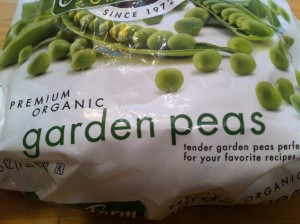
I grew up with a grandmother who made turkey and ham at Christmas, a chocolate meringue pie every time she knew my dad was visiting, and who once spent an entire week preparing food for a family reunion. I grew up watching my mother wrestle apart a whole chicken in the afternoon before dinner and thinking of frozen TV dinners as treats because we only had them when my parents went out and we were with a babysitter. For a long time I didn’t quite believe that anyone actually ate Kraft macaroni and cheese. Though I saw the ubiquitous ads, I never once saw it on my plate or in our house, so it remained one of those bizarre things I both knew about and didn’t – until I got to college and found out that other people had different versions of cooking.
I’m not glorifying anything. My grandmother was an excellent cook and my mom is, too. Many meals were homemade, though both of them routinely used boxed mixes for cake and brownies. I’m not trying to talk about purity here. I’m simply describing what I grew up with as “normal.”
It was also normal in our family for women to work. I’m not adding “outside the home,” because for the first 37 years of her life, my grandmother worked on farms. She was back and forth between the fields and the kitchen and they were long days. After that, she worked in a Woolworth and I remember many Christmas Eves waiting for her shift to end so we could have dinner and open presents – yes, she cooked the dinner, too. My mother earned her graduate degree part-time while we were very young and then worked full-time from the time I was 10 years old. Among their many responsibilities, both women cooked for us. (It was also normal in my family, at least sometimes, for men to cook. In the hectic days of high school, my dad was the one to have breakfast ready for all of us each morning before we zoomed out the door in multiple directions.)
I’m contemplating family and cooking after reading Emily Matchar’s fascinating book Homeward Bound: Why Women Are Embracing the New Domesticity. It’s a bigger book than this one issue, but this is the one sticking with me at the moment. In the book she describes women who are hands-on about every moment of the food process, from growing and raising it, to canning and slaughtering, to preparing it for the plate. She highlights people who grind their own flour, make their own baby food, and attempt to become self-sufficient producers of all the food their families eat. Clearly, that’s one end of a continuum. The other end is the person who buys only prepared and fast food and uses the oven for storage.
Matchar has written in other places about the new tyranny of cooking imposed by people like Michael Pollan. She points out that not everyone likes to cook and that now it’s easier than ever to find healthy fast food and prepared food alternatives to the drudgery of cooking.
Anything can become drudgery. I suppose there may be some folks for whom preparing food would always constitute drudgery. Certainly, working 12 hours in the field and then coming back to the kitchen to prepare a full meal for the rest of the hungry field crew would wear on you. I’m sure there were days when my grandmother didn’t feel like making dinner. I suppose there may even be people who just aren’t that into food and honestly can’t taste the difference between homemade marinara and sauce from a jar.
What’s interesting in Matchar’s book is the prevalence of the phrase “from scratch cooking.” In fact, she rarely talks about cooking without the word “scratch” in front of it. Having grown up as I did, this is sort of like saying “cooking cooking.” It highlights how little many people actually cook and it emphasizes a purity test for what counts as cooking (think, grinding your own flour vs. buying an already roasted chicken and making a few side dishes to go with it).
I’m a fan of utilitarian, go-to meals and I also like exploring new recipes, occasionally even those that should only be tried with a culinary degree. I know the comfort of ordering take out after a long day, which I invariably think of as “someone else cooking for me.” I also know the satisfaction of watching the raw ingredients turn into something amazing, just because I followed the steps. Many, many days, I know the comfort of a good enough meal, pulled together and eaten at home without much fuss or time.
Bottom line: It doesn’t all have to be Julia Child and it doesn’t have to take hours to prepare. You can even use some pre-made ingredients to help yourself out. It is almost always less expensive and better-tasting when you cook/make it yourself. There is nothing wrong with a tub of store-bought hummus but why not learn or collect a few easy, inexpensive, healthful, and delicious standbys?
In a week in which we had this throwback to 1950s advertising, it’s important to say it outright: I’m a feminist and I cook. One of the themes of Matchar’s book is the way in which the “new domesticity” young women assert that they are “reclaiming” cooking after “feminism told women that cooking was drudgery and shoved them out of the kitchen.” This is not and never was feminism. Feminism is about expecting all of the people who want to eat to help cook it. Feminism is about expecting the world outside of the kitchen to treat men and women equally for the work they do there.
I cook because I need to eat and because it’s a creative and rewarding endeavor. (I also work because I need to eat.) And I work because I am called to it. That’s the best of both worlds and I know it. To truly love your work and to love the creativity and beauty of feeding and being fed are all blessings.
A few years ago we had a bread-baking retreat at the campus ministry where I work. We spent the afternoon learning how to bake bread and, while it was rising, reflecting on the prayer we offer during Communion. Men and women – none of them who’d ever made bread previously – created the loaves we carried into worship that evening. This wasn’t drudgery or a waste of our time. And that bread tasted better than our usual loaf.
Working with young folks and having read Matchar’s book, I realize that a lot of people just don’t know where to start. If you didn’t grow up with pies and homemade macaroni and cheese, it isn’t too late! To help anyone else out there who may be tired of your own standbys or who may want to learn a few, I’ll be posting 4 or 5 of my simplest and most satisfying recipes over the next few weeks. So for all of you men and women who may want to include a few more meals at home, here’s the first of my standby recipes. Bon appétit!
Standby Recipes #1: Greek Salad
This one is especially refreshing and satisfying in the summer months. Use any variety of the items below and feel free to change it up to fit your mood.
Put any or all of these ingredients into a large bowl or plate and drizzle with your favorite salad dressing:
- 3-4 leaves of lettuce, torn by hand into bite sized pieces (red-leaf, green-leaf, romaine, or whatever you like)
- Handful of canned garbanzo beans (Rinse them first. You’ll have leftovers for another salad later in the week.)
- Chopped red onion
- Sliced or diced cucumbers
- Diced fresh tomatoes (you can use cherry or grape tomatoes cut in half)
- 4-6 halved, pitted kalamata olives (you can often find these on an olive or salad bar at the grocery store)
- Generous sprinkling of Feta cheese, crumbled or diced
- 2-4 pepperoncini peppers
- Hardboiled egg, sliced in half or quarters (The only cooking required in this one!)
- Black pepper, sprinkled on top






